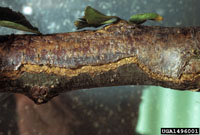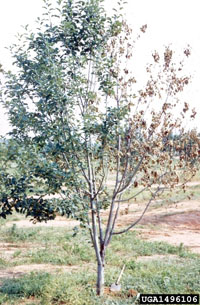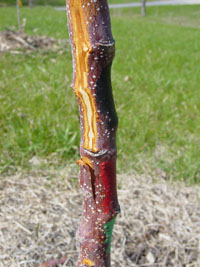Extension > Garden > Diagnose a problem > What's wrong with my plant? > Deciduous Trees > Crab Apple > Discolored, cracked or sunken area
Crab Apple > Branch > Discolored, cracked or sunken area
1 of 5
Fire Blight
Erwinia amylovora
- Branch cankers have dark, sunken and cracked bark, sapwood is streaked reddish brown
- Young shoots bend over forming a 'shepherd's crook'
- Infected leaves wilt, turn gray then dark brown
- Infected blossoms first turn gray, then black
- Infected leaves and blossoms remain attached to the tree, often even in winter
- Infected fruit are shriveled and discolored
- Drops of sticky honey colored liquid can be seen on infected plant parts in warm wet weather
- More information on Fire Blight
2 of 5
Black Rot
Botryosphaeria obtusa
- Branch cankers can be sunken, reddish brown or rough looking or cracked bark; cankers may remain small or enlarge to become several feet long
- Leaves on girdled branches wilt, die and turn brown
- Round leaf spots with a purple border and tan center
- Large brown spots with brown rings form on fruit
- Fruit is rotted but remains firm
- Fruit may become mummified and remain on tree
- Common on stressed trees and trees infected with fire blight
- More information on Black Rot
3 of 5
White Rot
Botryosphaeria dothidea
- Branch infections grow to cracked, flakey, orange canker
- Leaves on girdled branches wilt, die and turn brown
- Sunken brown spots on fruit, can grow to rot part or all of fruit
- Fruit rot is soft, watery and extends to the core of the apple
- Small blister like spots on branches exude, watery fluid
- For management information see Black Rot
4 of 5
Winter Injury
- Injured branches leaf out and then die, or don’t leaf out at all
- Injured shoots and branches die quickly after warm weather arrives
- Common after very cold winters with little snow cover
- Dark streaking can be seen in the sapwood of injured branches
- More information on Winter Injury
5 of 5
Sunscald
- Vertical Cracks appear primarily on the south and southwest side of branch or trunk
- Occurs during winter, often noticed early spring
- More information on Sunscald














